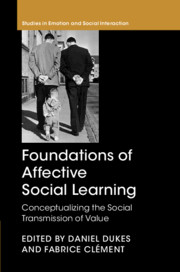Book contents
- Foundations of Affective Social Learning
- Studies in Emotion and Social Interaction
- Foundations of Affective Social Learning
- Copyright page
- Dedication
- Contents
- Figures
- Contributors
- Preface
- A difficult introduction to affective social learning
- Part I On the evolutionary foundations of affective social learning processes
- Chapter 1 Social learning among wild orang-utans
- Chapter 2 Affective social learning and the emotional side of cultural learning in primates
- Part II On human development and affective social learning
- Part III On the mechanics of affective social learning
- Part IV Applications of affective social learning
- Conclusion
- Index
- Studies in Emotion and Social Interation
- References
Chapter 1 - Social learning among wild orang-utans
Is it affective?
from Part I - On the evolutionary foundations of affective social learning processes
Published online by Cambridge University Press: 09 August 2019
- Foundations of Affective Social Learning
- Studies in Emotion and Social Interaction
- Foundations of Affective Social Learning
- Copyright page
- Dedication
- Contents
- Figures
- Contributors
- Preface
- A difficult introduction to affective social learning
- Part I On the evolutionary foundations of affective social learning processes
- Chapter 1 Social learning among wild orang-utans
- Chapter 2 Affective social learning and the emotional side of cultural learning in primates
- Part II On human development and affective social learning
- Part III On the mechanics of affective social learning
- Part IV Applications of affective social learning
- Conclusion
- Index
- Studies in Emotion and Social Interation
- References
Summary
In this chapter, we apply the affective social learning (ASL) concept to the social learning of natural skill sets in immature orang-utans since it can serve as an illustration of the majority of learning that occurs in wild apes. Most orang-utan social learning happens during everyday tasks and without any active involvement of the role model. Consequently, detecting the emotional state(s) of the role model is nearly impossible. We focus therefore on the emotional responses of the immature learners to the role models’ behaviours. Our data on peering (attentive, sustained close-range watching of conspecifics), which is often followed by selective practice of the observed behaviour by the peerer, suggests that there is some highly specific emotional arousal of the immatures during social learning. The role models’ actions with the object seem to play a central role in the learning process. However, immatures appear to decide on their own whether to attend to the information or not, as in affective observation, the second stage of ASL. Developmental changes in role-model preferences support the notion that trust in the role model is critical for ASL to work. Given that we can use the learners’ responses as proof of the affective states of the role models, ASL may be an important part of the mechanism that guides and optimizes the acquisition of learned skills in wild great apes. However, the lower we set the bar for the affective states (or emotions) of the role models for ASL to work, the more difficult it is to verify their presence and the more ASL will overlap with ordinary social learning.
- Type
- Chapter
- Information
- Foundations of Affective Social LearningConceptualizing the Social Transmission of Value, pp. 25 - 40Publisher: Cambridge University PressPrint publication year: 2019
References
- 3
- Cited by

